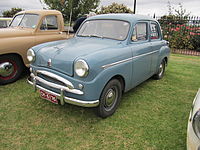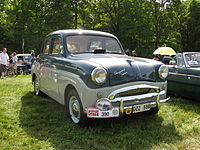
The Standard Ten was a model name given to several small cars produced by the British Standard Motor Company between 1906 and 1961. The name was a reference to the car's fiscal horsepower or tax horsepower, a function of the surface area of the pistons. This system quickly became obsolete as an estimate of the power produced by the engine, but it continued to be relevant as a way to classify cars for tax purposes. Like other manufacturers, Standard continued to use the name to define the approximate size of their 'Ten' model long after the origins of the name had, in Britain, become inapplicable.
An experimental two-cylinder "10" was made in 1906, after which Standard's next car in that category was a four-cylinder 9.5 tax horsepower built between 1914 and 1919. They returned to the 10 tax horsepower market in 1934; this model was replaced in 1937 by a "Flying Ten" that lasted until the outbreak of World War II.
Standard again returned to the 10 tax horsepower market in 1954 with another Ten, which was supplemented in 1957 by an up-market version called the Pennant. The Ten and the Pennant were replaced by the Triumph Herald in 1961.
Edwardian 10 hp cars
Motor vehicle| Standard 9.5 hp | |
|---|---|
| Overview | |
| Manufacturer | Standard Motor Company |
| Production | 1914–1915, 1919 |
| Body and chassis | |
| Layout | FR |
| Powertrain | |
| Engine | inline four side-valve engine 1914–1915: 1087 cc 1919: 1328 cc |
| Dimensions | |
| Wheelbase | 1914–1915: 2,286 mm (90 in) 1919: 2,336.8 mm (92 in) |
| Length | 1914–1915: 3,200 mm (126 in) 1919: 3,277 mm (129 in) |
| Chronology | |
| Successor | 1934 Standard 10 hp |
The name was first used in 1906 on an experimental two-cylinder 10 tax horsepower car. The side-valve engine had a 70 mm bore and an 82 mm stroke, giving a capacity of 631 cc.
A 9.5 tax horsepower four-cylinder car was introduced in 1914 and built until 1915. A version of this car, with increases in wheelbase and engine stroke, was offered in 1919.
10 hp (1934–1936)
Motor vehicle| Standard 10 hp | |
|---|---|
 | |
| Overview | |
| Manufacturer | Standard Motor Company |
| Production | 1934–1936 |
| Body and chassis | |
| Layout | FR |
| Powertrain | |
| Engine | 1343 cc inline four side-valve engine |
| Dimensions | |
| Wheelbase | base: 2,311 mm (91 in) optional: 2,388 mm (94 in) |
| Chronology | |
| Predecessor | 1919 Standard 9.5 hp |
| Successor | 1934 Standard 10 hp |
| This section is empty. You can help by adding to it. (October 2014) |
Flying Ten
Motor vehicle| Standard Flying Ten | |
|---|---|
| Overview | |
| Production | 1937–1939 |
| Body and chassis | |
| Body style | saloon 2 door coupe utility |
| Powertrain | |
| Engine | 1267 cc Inline-four engine |
| Transmission | Three speed manual |
| Dimensions | |
| Wheelbase | 90 in (2,286 mm) |
| Length | 152 in (3,861 mm) |
| Width | 56.5 in (1,435 mm) |
The Flying Ten was a replacement for the earlier Ten with the semi-streamlined look of the Standard Flying range. The side-valve 1267 cc long stroke (100 mm) engine had a single Zenith carburettor and could produce 33 bhp (25 kW) at 4000 rpm. Drive was to the rear wheels through a 3-speed synchromesh gearbox. The suspension was conventional at first with a solid front axle but this was upgraded to an independent set-up at the front with a transverse leaf spring in 1939. A top speed of around 65 mph (105 km/h) was attainable. Brakes were cable operated using the Bendix system. In early 1941, 150 four-doors were built for the military, after civilian production had ceased.
A sportier version, the Light Flying Ten was also made.
Post-war models
Motor vehicle| Standard Ten | |
|---|---|
 1954 Standard Ten Saloon 1954 Standard Ten Saloon | |
| Overview | |
| Also called | Standard Companion (estate) Standard 6 cwt (van & pickup) Standard Cadet (Australia) Standard Vanguard Junior (Sweden) Triumph TR-10 (United States) |
| Production | May 1954–1960 172,500 made |
| Assembly | United Kingdom Australia India |
| Body and chassis | |
| Body style | 4-door saloon 4-door estate car 2-door coupe utility 2-door panel van |
| Powertrain | |
| Engine | 948 cc OHV I4 |
| Transmission | Four speed manual optional overdrive |
| Dimensions | |
| Wheelbase | 84 in (2,134 mm) |
| Length | 144 in (3,658 mm) |
| Width | 60 in (1,524 mm) |
| Height | 60 in (1,524 mm) |
In 1954 the Ten was introduced as a more powerful, better-appointed version of the Standard Eight, with the Eight's Standard SC engine increased in size to 948 cc and sharing a similar frame and transmission. Overdrive (from March 1957) or a temperamental semi-automatic were available as options.
An estate (station wagon) version, the Companion, was launched in June 1955. It was among the first small British estate cars to have rear-passenger doors (like the saloon, and unlike its rivals such as the Ford Squire and Hillman Husky which used the two-door "van" arrangement).
A small number of left-hand-drive Tens were exported to the US and sold as the Triumph TR-10. On these, the two-tone colour arrangement normally reserved for the Pennant was available (though this export model was not tailfinned).
A Ten saloon tested by the British magazine The Motor in 1954 had a top speed of 69.0 mph (111.0 km/h) and could accelerate from 0-60 mph (97 km/h) in 38.3 seconds. A fuel consumption of 34.4 miles per imperial gallon (8.2 L/100 km; 28.6 mpg‑US) was recorded. The test car cost £580 including taxes.
In 1955, supported by an inscrutable handicapping régime favouring small cars, a factory-prepared Standard Ten, driven by Jimmy Ray and Brian Horrocks, won the UK's RAC Rally.
For the United States export market the car was badged as the Triumph 10 and in Scandinavia it was sold as the Standard Vanguard Junior. In Australia the Ten was known as the Cadet.
-
1959 Standard Ten (facelifted model)
-
 Standard Companion estate car
Standard Companion estate car
-
 Standard Companion estate car
Standard Companion estate car
-
 Standard 6 cwt pickup
Standard 6 cwt pickup
-
 Australian market Standard Cadet
Australian market Standard Cadet
-
 A Scandinavian Standard Ten badged as the Vanguard Junior
A Scandinavian Standard Ten badged as the Vanguard Junior
-
 Triumph 10 (Canada)
Triumph 10 (Canada)
Standard Pennant
Motor vehicle| Standard Pennant | |
|---|---|
 | |
| Overview | |
| Production | 1957–1960 42,910 made |
| Body and chassis | |
| Body style | saloon, estate |
| Related | Standard Atlas |
| Powertrain | |
| Engine | 948 cc Straight-4 OHV |
| Transmission | Four speed manual optional overdrive |
| Dimensions | |
| Wheelbase | 84 in (2,134 mm) |
| Length | 142 in (3,607 mm) |
| Width | 59 in (1,499 mm) |
| Height | 60 in (1,524 mm) |
A tail-finned (with optional two-tone paint schemes) version of the Ten, the Standard Pennant was launched in October 1957. Engine power was increased to 37 bhp and an overdrive gearbox was offered as an option. other options included a radio, heater, leather upholstery and clutchless two-pedal control. Indian-produced Pennants were branded as "Standard 10", and lacked any bootlid trim other than the branding.
A Pennant tested by British magazine The Motor in 1958 had a top speed of 70.2 mph (113.0 km/h) and could accelerate from 0-60 mph (97 km/h) in 35.3 seconds. A fuel consumption of 40.2 miles per imperial gallon (7.03 L/100 km; 33.5 mpg‑US) was recorded. The test car cost £728 including taxes of £243.

References
- Footnotes
- ^ Culshaw & Horrobin 2013, p. 282.
- Culshaw & Horrobin 2013, p. 281.
- ^ Culshaw & Horrobin 2013, p. 284.
- 1940 Standard Flying 10 Utility, www.justcars.com.au, as archived at web.archive.org
- ^ British commercial brochures Retrieved on 28 October 2011
- Standard Eight Has 'Big Brother', The Advertiser, Thursday 9 September 1954, page 20, as archived at trove.nla.gov.au
- ^ The Standard 10, vintagetriumphregister.org Retrieved 24 March 2017
- ^ "Standard 8's and 10's Commission Numbers". Standard Motor Club. Archived from the original on 20 February 2012.
- ^ Robson 2006, p.
- Australian Motor Industries (AMI) The Start Retrieved on 30 March 2012
- ^ Culshaw & Horrobin 2013, p. 287.
- "Second Hand car guide supplement". Practical Motorist. 6 Nbr 68: between pages 768 & 769. April 1960.
- "The Standard Ten". The Motor. 4 August 1954.
- Robson 1977, pp. 40–41.
- Homer, Phil. "8's and 10's". Standard Motor Club. Archived from the original on 20 February 2012.
- ^ "The Standard Pennant". The Motor. 10 September 1958.
- Bibliography
- Culshaw, David; Horrobin, Peter (2013) . "Standard". The Complete Catalogue of British Cars 1895 - 1975 (e-book ed.). Poundbury, Dorchester, UK: Veloce Publishing. pp. 281–287. ISBN 978-1-845845-83-4.
- Robson, Graham (19 November 1977). "XK to Escort – 25 years of RAC Rallies". Autocar. 147 (4228): 40–41.
- Robson, G. (2006). A-Z of British Cars 1945–1980. Devon, UK: Herridge Books. ISBN 0-9541063-9-3.
| Triumph Motor Company timeline, 1946 to 1984 — a marque of British Leyland | |||||||||||||||||||||||||||||||||||||||||||||||||||||||||||||||||||||||||||||||||||||||||||||||||||||||||||||||||||||||||||||||||||||||||||||||||||||||||||||||||||||||||||||||||||||||||||||||||||||||||||||||||||||||||||||||||||||||||||||||||||||||||||||||||||||||||||||||||||||||||||||||||||||||||||||||||||||||||||||||||||||||||||||||||||||||||||||||||||||||||||||||||||||||||||||||||||||||||||||||||||||||||||||||||||||||||||||||||||||||||||||||||||||||||||||||||||||||||||||||||||||||||||||||||||||||||||||||||||||||||||||||||||||||||||||||||||||||||||||||||||||||
|---|---|---|---|---|---|---|---|---|---|---|---|---|---|---|---|---|---|---|---|---|---|---|---|---|---|---|---|---|---|---|---|---|---|---|---|---|---|---|---|---|---|---|---|---|---|---|---|---|---|---|---|---|---|---|---|---|---|---|---|---|---|---|---|---|---|---|---|---|---|---|---|---|---|---|---|---|---|---|---|---|---|---|---|---|---|---|---|---|---|---|---|---|---|---|---|---|---|---|---|---|---|---|---|---|---|---|---|---|---|---|---|---|---|---|---|---|---|---|---|---|---|---|---|---|---|---|---|---|---|---|---|---|---|---|---|---|---|---|---|---|---|---|---|---|---|---|---|---|---|---|---|---|---|---|---|---|---|---|---|---|---|---|---|---|---|---|---|---|---|---|---|---|---|---|---|---|---|---|---|---|---|---|---|---|---|---|---|---|---|---|---|---|---|---|---|---|---|---|---|---|---|---|---|---|---|---|---|---|---|---|---|---|---|---|---|---|---|---|---|---|---|---|---|---|---|---|---|---|---|---|---|---|---|---|---|---|---|---|---|---|---|---|---|---|---|---|---|---|---|---|---|---|---|---|---|---|---|---|---|---|---|---|---|---|---|---|---|---|---|---|---|---|---|---|---|---|---|---|---|---|---|---|---|---|---|---|---|---|---|---|---|---|---|---|---|---|---|---|---|---|---|---|---|---|---|---|---|---|---|---|---|---|---|---|---|---|---|---|---|---|---|---|---|---|---|---|---|---|---|---|---|---|---|---|---|---|---|---|---|---|---|---|---|---|---|---|---|---|---|---|---|---|---|---|---|---|---|---|---|---|---|---|---|---|---|---|---|---|---|---|---|---|---|---|---|---|---|---|---|---|---|---|---|---|---|---|---|---|---|---|---|---|---|---|---|---|---|---|---|---|---|---|---|---|---|---|---|---|---|---|---|---|---|---|---|---|---|---|---|---|---|---|---|---|---|---|---|---|---|---|---|---|---|---|---|---|---|---|---|---|---|---|---|---|---|---|---|---|---|---|---|---|---|---|---|---|---|---|---|---|---|---|---|---|---|---|---|---|---|---|---|---|---|---|---|---|---|---|---|---|---|---|---|---|---|---|---|---|---|---|---|---|---|---|---|---|---|---|---|---|---|---|---|---|---|---|---|---|---|---|---|---|---|---|---|---|---|---|---|---|---|---|---|---|---|---|---|---|---|---|---|---|---|---|---|---|---|---|---|---|---|---|---|---|---|---|---|---|---|---|---|---|---|---|---|---|---|---|---|---|---|---|---|---|---|---|---|
| |||||||||||||||||||||||||||||||||||||||||||||||||||||||||||||||||||||||||||||||||||||||||||||||||||||||||||||||||||||||||||||||||||||||||||||||||||||||||||||||||||||||||||||||||||||||||||||||||||||||||||||||||||||||||||||||||||||||||||||||||||||||||||||||||||||||||||||||||||||||||||||||||||||||||||||||||||||||||||||||||||||||||||||||||||||||||||||||||||||||||||||||||||||||||||||||||||||||||||||||||||||||||||||||||||||||||||||||||||||||||||||||||||||||||||||||||||||||||||||||||||||||||||||||||||||||||||||||||||||||||||||||||||||||||||||||||||||||||||||||||||||||